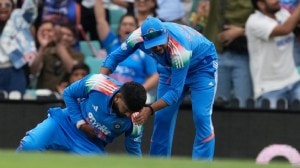Presenting First dancing girl, Calcutta
November 1902. A makeshift recording studio had been set up in two rooms of a hotel in Kolkata by the Gramophone Company. Fredrick William G...

November 1902. A makeshift recording studio had been set up in two rooms of a hotel in Kolkata by the Gramophone Company. Fredrick William Gaisberg and his assistants had arrived just three weeks ago from England, on their first Far East recording expedition for the company.
They had appointed a local agent for selecting and training artists for recording on gramophone discs. But the agent selected Anglo-Indian artists and completely ignored local talent. Gaisberg then sought the help of the local police superintendent, visited several theatres, attended mehfils at zamindars’ palaces and found at least one promising artist to begin with. She was a very famous dancing girl, and her voice was very sweet, though not for European ears. She agreed to a recording session for the handsome fee of Rs 3,000.
At around 9 a.m, a 30-year-old fair, medium-built woman along with her accompanists and relatives entered the studio. A thick wax master record was placed on the turntable rotating at 78 rpm. A huge recording horn was fitted on the wall behind her and close to her face, and she was asked to sing loudly into the horn.
Gaisberg requested her to sing for three minutes and to announce her name at the end of the recording. She announced: ‘‘My name is Gauhar Jan’’. This was necessary, since the wax masters were sent to Hanover in Germany for pressing the records, and the technicians would make proper labels and confirm the name by listening to these announcements at the end of the performance.
Sound recording may have been invented in 1877 but it took 20 years for the technology to mature. And 25 years later, in 1902, the first ever recording of Indian classical music was engraved in the ‘‘grooves’’ of a gramophone record. The song can be played even today on a shellac record, and Gauhar Jan will sing it faithfully for music lovers as long as the technology to play back that singing exists.
Gauhar Jan’s initial name was Angelina Yeoward. Her father, William Robert Yeoward, was an Armenian Jew working as an engineer in a factory producing dry ice at Azamgadh near Benares. He married a Jewish lady, Victoria Hemming, around 1870, who was born and brought up in India. Angelina was born in 1873.
But her parents’ marriage did not last long due to Victoria’s love for dance and music and her relations with a Muslim friend, Khurshed. After a divorce, she moved to Benares with Angelina and Khurshed and adopted Islam as her religion. Mother and daughter adopted new names: Malka and Gauhar.
Malka spent eight years learning the art and emerged as a well trained baiji. She became popular as Badi Malka Jan, badi (elder) because at that time three other Malka Jans were famous—Malka Jan of Agra, Malka Jan of Mulk Pukhraj and Malka Jan of Chulbuli. Around 1883, the trio moved to Kolkata.
Little Gauhar too was fond of dance and music, and Malka appointed special teachers to teach her languages, literature, and of course, dance and music. Kale Khan of Patiala, alias Kalu Ustad, and Ustad Vazir Khan of Rampur trained her in pure and light classical Hindustani vocal music; Ali Baksh and Brindadin Maharaj taught her Kathak.
Srijanbai taught her dhrupad dhamar and Charan Das trained her in Bengali Keertan. She also learnt from her contemporaries—Mojuddin Khan, Bhaiyya Ganpatrao and Peara Saheb. She penned compositions under the name ‘Hamdam’, and she also wrote, composed and recorded ghazals.
Gauhar Jan first performed in Darbhanga State at the age of 15, and in Kolkata from 1896. She was in great demand, and Gaisberg noticed this and made her music available to listeners through her gramophone records.
Gauhar Jan recorded prolifically, a total of over 600 songs between 1902 and 1920, and she sang in more than ten languages. From 1903, her records began to appear on the market. In 1908, a record-pressing factory was built at Sealdah. Gaisberg was invited for this occasion and recorded a few more songs of Gauhar Jan. This time, the announcement of her name at the end was not required.
The early records of Gauhar Jan are labelled ‘First dancing girl, Calcutta’. She cut records of raagdari sangeet, thumri, dadra, kajri, chaiti, bhajan, tarana and she popularised various types of kachha gana through her records. This was remarkable when several stalwarts of classical music ignored the gramophone and recording medium completely and refused to record. She mastered the technique of presenting a musical item in just three minutes, and this became a model for the vocalists of the future.
Gauhar Jan lived a very wealthy life. Numerous stories are associated with her: how, she threw a party spending 20,000 rupees when her cat produced a litter of kittens, how she donated only half the promised amount to Gandhiji’s Swaraj Fund when he did not keep his promise of attending the fund raising concert and deputed a representative instead.
But in her personal life, she was deceived by her friends and relatives. She married her personal secretary, Saiyyad Gulam Abbas from Peshawar, a man ten younger than her, who soon got involved with other women. Later, she stayed with Amrut Vagal Nayak in Bombay, a handsome actor on the Gujrathi stage. This relation lasted for 3-4 years, and she learnt several songs composed by him including the famous Dadra Aan Ban Jiyamen Lagi.
Nayak’s sudden demise was a big jolt. Relatives persuaded her to return to Kolkata but she did not stay there long, moving to Darbhanga instead. She joined the service of the Mysore State, where she died in 1930. She left over 150 records, most of which are in the safe custody of record collectors. The Gramophone Company reissued 18 songs in 1994 on audio tape and CD under the banner of ‘Chairman’s Choice’, which no one (except perhaps the Chairman) noticed due to lack of adequate publicity.
(The writer is Honorary Secretary of the Society of Indian Record Collectors, Mumbai)



- 01
- 02
- 03
- 04
- 05




























